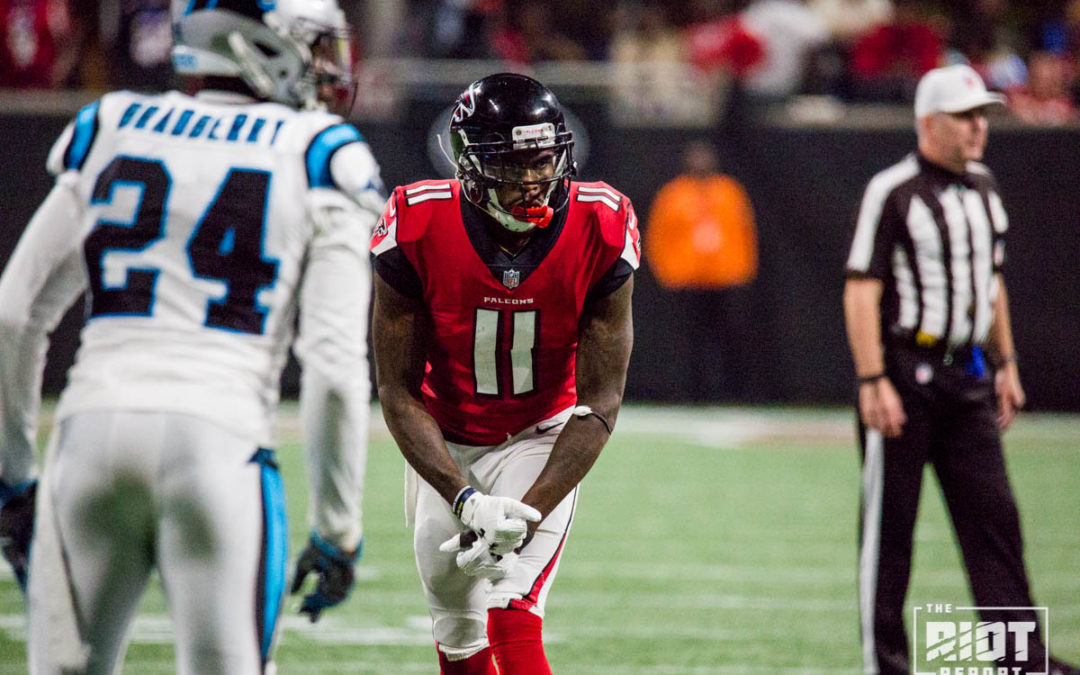The Deep Dig
When looking at Jones’s targets against the Eagles, something of a pattern emerges:
The Falcons repeatedly and effectively targeted Jones on a variety of deep dig and out routes, looking to take advantage of the Eagles use of three-deep and single-high zone coverages. On a isolated play, these routes are extremely effective, as the defender’s primary obligation is to take away the deep third. Of course, football isn’t a series of isolated plays, and so having been beaten by this route, the corner has a chance to wait on the receiver breaking back to the ball and is able to knock the pass away:
However, the Falcons know the teams will start to look to attack this route, and so they can pair it with a stutter-and-go, which takes advantage of the corner’s desire to attack the dig:
Julio was judged not to have come down with the ball on this play, but if paired with an accurate pass this would have been a surefire touchdown. So if this route can’t be defended simply by knowing it might be coming, how can the Panthers’ defense look to prevent the Falcons tearing them apart with this route concept?
The simple answer is that it requires more than one defender to stop, as the defense needs to be able to split the responsibility for the deep third and the dig between two defenders. This either means having a safety shade over the top to take away the deep third while having the corner focus on routes which break back to the ball or having the corner take the deep third as usual but drop an underneath coverage player deeper than usual to take away the dig.
The Falcons did try something similar to this on the first dig route shown, but the delay by the underneath defender; generated by the run fake gave Ryan enough time to get the ball out before the underneath defender arrived. If the Panthers can execute this defensive concept slightly better than the Eagles could, they have a chance of not being systematically picked apart by this route concept in the way the Eagles were.
However, the Falcons have another ace up their sleeve, as they know that teams will modify their defense in order to take away this route concept, and they use the threat of the dig route to set up other passing concepts. On the following play, the Eagles are in another cover 3 look, and the corner is responsible for the deep third with a defender underneath. With a receiver in the flat, the Falcons have the potential to run a smash concept on the far side, with the read being whether the underneath defender focuses on the dig or the flat; however, the Falcons will be aware of this, and so as with some of the earlier plays, the deep third corner is effectively isolated on Jones. This allows Jones to hesitate to take the dig and then break inside for a wide open target for a long gain:
The Eagles, however, tried something to try and attack this exact pattern, they were very nearly rewarded with a pick for their hard work and ingenuity. The Eagles are in man coverage across the board, with one safety deep – he can take away the stutter-and-go – and an underneath safety to take away the short middle. The Falcons run a drag underneath to try and isolate Jones against the corner, who Jones is able to freeze with an outside fake before breaking inside. The key to this play defensively is the underneath safety, sometimes referred to as a ‘robber’, who is responsible for trying to force a more difficult throw to the boundary. Ryan does a good job of holding him on the drag route and so when he then looks to throw to Jones the robber is unable to get across fast enough to make the pick and the Falcons get their completion:
What the Panthers have that the Eagles didn’t, however, is one of the best underneath zone coverage players in the NFL: Luke Kuechly.
Kuechly has an extremely rare combination of athleticism and intelligence that allows him to diagnose route combinations and attack the ball. If the Panthers are able to use Kuechly to deny Jones easy access to the intermediate middle and force Ryan to attempt difficult outside throws into tight windows, the Panthers will likely live with whatever Jones can make from that. This also goes for the more conventional Cover 3 beaters the Falcons run with Jones that don’t rely on holding the corner on the outside routes:
Of course, there is another way to attack these passing concepts, in fact a way to attack almost any passing concept.
Pressure.
On both of the following plays, the Falcons run the same dig concept but the Eagles are able to get pressure without having to blitz. In the first instance this forces Ryan to break his progression off before the throw comes open and on the second play, Ryan is forced to simply heave the ball in the general direction of Jones and is lucky to get away with it.
If the Panthers are able to get pressure on a consistent basis then they will prevent the Falcons from having the time to set up these deep passing concepts where Jones is so effective. If they can do this, then they have every chance of limiting Jones. After all, for receivers at the NFL level getting separation is largely a matter of when not if, and if Jones’s impact is limited to slow-developing routes in the deep thirds then the Panthers will likely take their chances, as for every play like this:
There are going to be ones like this:



